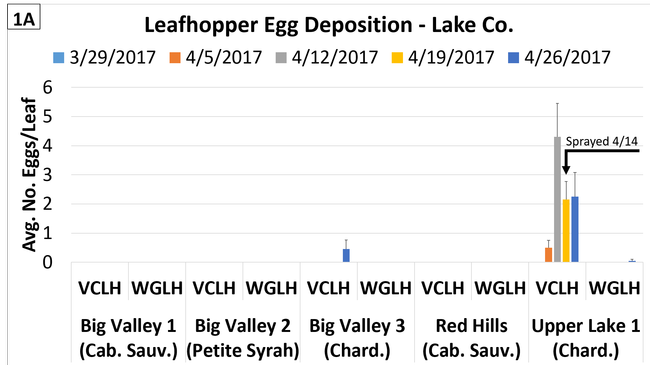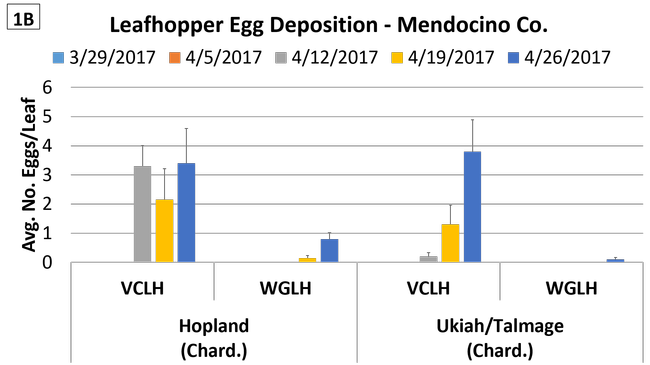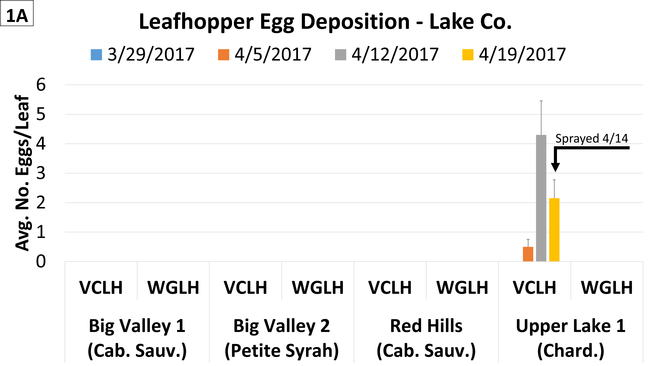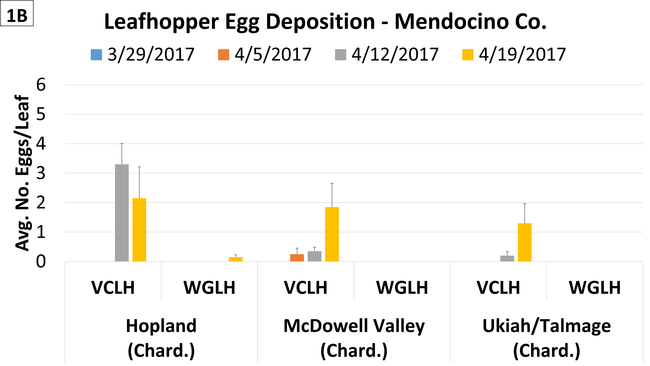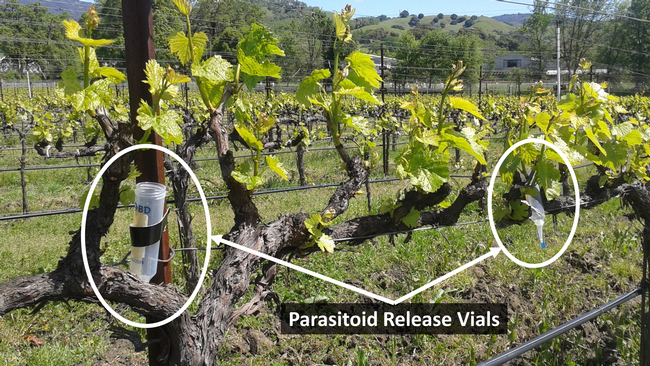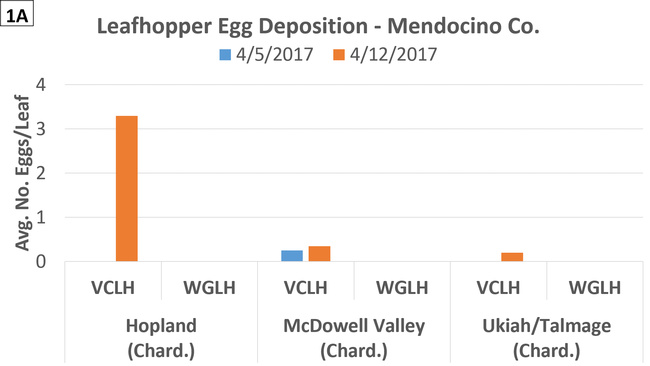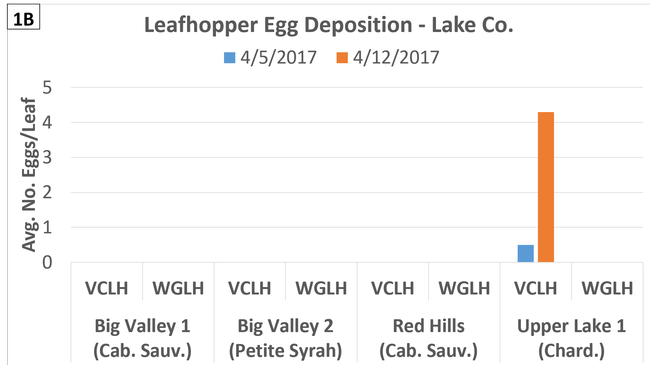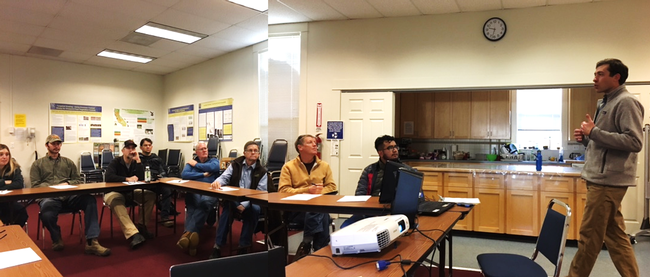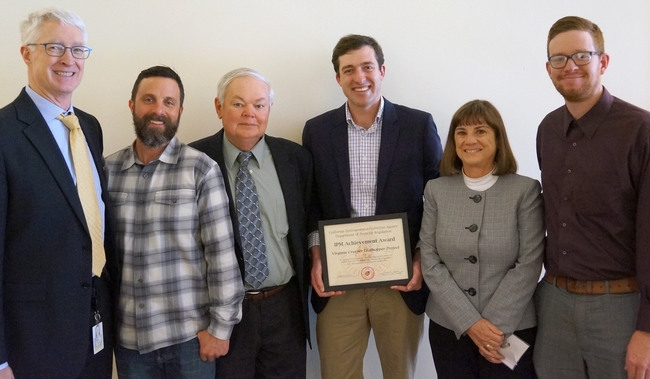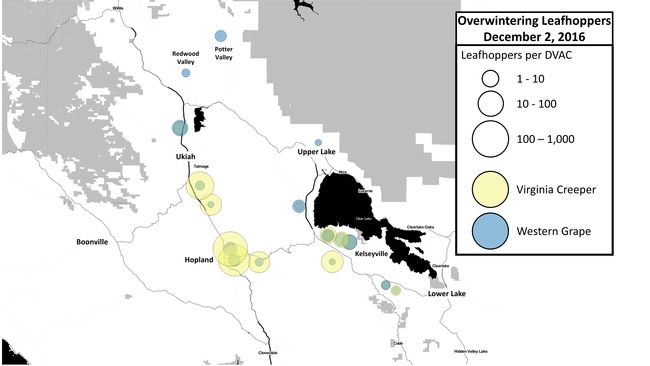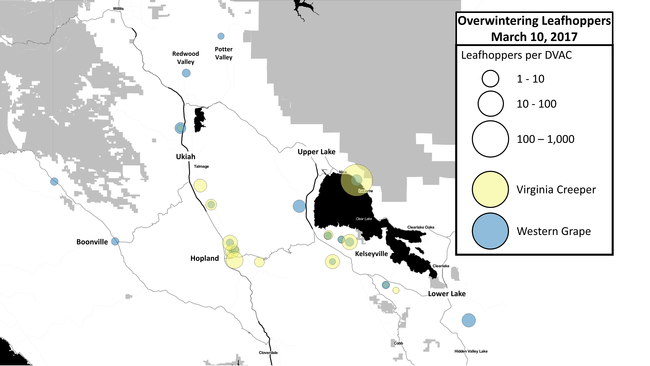- Author: Houston Wilson
Last week we made our first observations of Western grape leafhopper (WGLH) eggs on chardonnay in the Ukiah/Talmage and Upper Lake areas (Fig. 1). Egg deposition by Virginia Creeper leafhopper (VCLH) continues on white varieties in both counties. Leaf development of red varieties at the sites we're monitoring is still inadequate to support leafhopper egg deposition.
This past week we encountered a few VCLH eggs that showed signs of nymph emergence in a chardonnay vineyard near Hopland. This represented approximately 7% of the total VCLH eggs in that vineyard, but emergence will likely increase this week. We will begin to monitor for nymphs this week.
We have dropped the McDowell Valley site in Mendocino County since it was redundant with the Hopland site. A third site from Big Valley was added this week in order to track leafhopper development on a white variety in this region.
Another batch of Anagrus daanei, the parasitoid that attacks VCLH, was released in a vineyard near Talmage on April 28.
- Author: Houston Wilson
This week we observed the first eggs of the Western grape leafhopper (WGLH) on chardonnay near Hopland (Fig. 1B). Egg deposition by Virginia Creeper leafhopper (VCLH) continues to generally increase on white varieties in both Mendocino and Lake counties.
No eggs have been observed yet on red varieties that we're monitoring. While adults of both species are active at these sites, leaves of red varieties are not developed enough to support leafhopper egg deposition.
The vineyard we're monitoring in Upper Lake was recently sprayed, which likely accounts for decreased egg deposition (Fig. 1A). We're currently replacing this site with an unsprayed organic vineyard.
The first release of Anagrus daanei took place in a vineyard near Hopland on April 14.
- Author: Houston Wilson
Overwintering leafhopper adults are now active in vineyards, especially on earlier varieties, and can be found on developing shoots and leaves in the vine canopy. Virginia Creeper leafhopper (VCLH) egg deposition has already been observed at sites in both Mendocino and Lake counties. No eggs of the western grape leafhopper (WGLH) have been found yet.
Fig. 1 VCLH egg deposition has been observed as early as April 5 in both Mendocino (1A) and Lake (1B) counties. No WGLH eggs have been found yet.
- Author: Houston Wilson
WELCOME BACK!
It has been a long, wet winter but bud break is now upon us and we're getting ready to resume the regional leafhopper monitoring effort in Mendocino and Lake County as part of the Virginia Creeper Leafhopper Area-wide IPM Program. More details about this program, including an archive of these newsletters, can be found at the project website: http://ucanr.edu/sites/vclh/
"Leafhopper Newsletter" is now "Leafhopper Blog" - This year we're transitioning the Leafhopper Newsletter to a blog format in order to improve readability and create a better way for readers to send comments and feedback.
WINTER UPDATES
Project Report for Crop Year 2016 – In January we releaseda summary of findings and outcomes from our efforts over the 2016 season. You can access the report here: Annual Report for Crop Year 2016
Alliance Team Meeting – An Alliance Team Meeting was held on Jan. 24 to review project results to date and discuss plans and objectives for the 2017 growing season. One key outcome was that growers, PCAs and researchers decided to reduce the number of sites to include in the regional monitoring program in order to prioritize the parasitoid release efforts. You can access the minutes from this meeting here: Minutes from the Alliance Team Meeting - 1/24/17
Houston Wilson discusses plans for 2017 with collaborating PCAs and growers.
Project Receives “IPM Achievement Award” – The Area-wide IPM Program for Virginia Creeper Leafhopper received the 2016 “IPM Achievement Award” from the California Department of Pesticide Regulation (DPR). These awards are given out annually to groups of researchers, growers and PCAs that demonstrate outstanding leadership and collaboration in the field of IPM.
Representatives of the VCLH Area-wide Team in Sacramento: [L-R] Brian Leahy (Director, DPR), Ben Byczynski (Fetzer), Glenn McGourty (UCCE), Houston Wilson (UC Berkeley), Lucia Varela (UCCE), Ryan Keiffer (UCCE).
Parasitoid Rear-Release Program – During the winter, small colonies of Anagrus daanei are maintained in the greenhouse and then in the early spring expanded in preparation for the annual rear-release program. There were 4 colonies in 2016, but we are now able to support up to 9 colonies. In February, the first major expansion took place and there are now 7 active colonies in the greenhouse, with plans to build 2 more once additional artificial lights are installed. The first parasitoid releases are scheduled to begin on April 7.
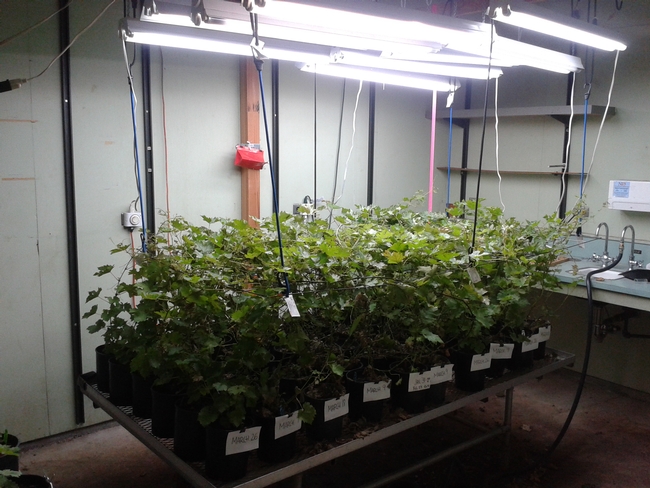 |
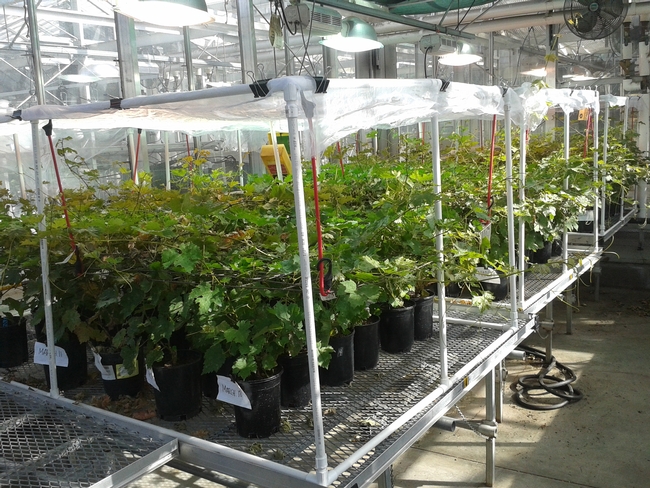 |
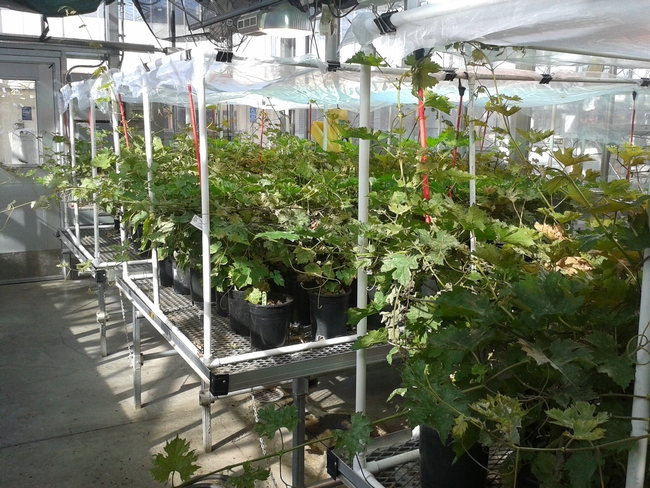 |
The small winter colony (left) was recently expanded into 7 larger summer colonies (middle and right) for the Anagrus daanei rear-release program. The first parasitoid release is scheduled for April 7.
Updates to the VCLH Project Website – http://ucanr.edu/sites/vclh/ – We are in the process of adding more images and videos of the leafhoppers and Anagrus parasitoids to the project website. Here are a few new videos we recently added:
- Anagrus daanei on a dime (for scale)
- Anagrus daanei parasitizing VCLH eggs
- Anagrus daanei searching for VCLH eggs
- Anagrus daanei emerging from a VCLH egg
REGIONAL MONITORING PROGRAM – CROP YEAR 2017
This year we are planning to monitor at a reduced number of sites (2-3 sites in Mendocino and 2-3 sites in Lake) in order to prioritize parasitoid release efforts. Where we do monitor, we plan to once again collect weekly data on leafhopper adult and nymph populations, egg deposition and parasitism rates. This data will be summarized and presented in the weekly Leafhopper Newsletter. Monitoring has already begun and the first results should be available the week of April 9.
Overwintering Leafhoppers – Winter 2016/2017
Both Virginia creeper leafhopper (VCLH) and western grape leafhopper (WGLH) overwinter in the vineyard as adults in reproductive diapause. During the winter and early spring they can be found taking shelter in leaf litter, weeds and cover crops. On warm days they can be found feeding on ground covers, but they do not reproduce on these plants.
This winter we sampled overwintering leafhoppers in December and March (Figure 1, Table 1). Our goal was to (1) get an idea of regional densities in anticipation of the regional monitoring and parasitoid release program and (2) compare changes in the overwintering populations at the beginning and end of winter, especially in light of the major rain events in the North Coast, where vineyard flooding could potentially reduce leafhopper populations.
Figure 1. Overwintering leafhopper densities on December 2, 2016 (Fig. 1A) and March 15, 2017 (Fig. 1B). VCLH densities are concentrated around the Ukiah/Talmage, Hopland, Big Valley, Upper Lake and Red Hills areas.
Fig 1A. - (click to enlarge)
Fig. 1B - (click to enlarge)
Table 1. Mean number of overwintering leafhoppers per DVAC sample in Dec. 2016 and Mar. 2017. Populations of both species declined over the winter at most sites. VCLH = Virginia Creeper Leafhopper and WGLH = Western Grape Leafhopper.
|
County |
Region |
12/2/2016 |
3/10/2017 |
Change Between Dec. 2016 – Mar. 2017 |
|||
|
VCLH |
WGLH |
VCLH |
WGLH |
VCLH |
WGLH |
||
|
Mendocino |
Anderson Valley 1 |
0 |
0.6 |
||||
|
Mendocino |
Anderson Valley 2 |
0 |
0.6 |
||||
|
Mendocino |
Redwood Valley |
0 |
0.8 |
0 |
0.8 |
0% |
|
|
Mendocino |
Potter Valley |
0 |
3 |
0 |
0.2 |
-93% |
|
|
Mendocino |
Ukiah |
4 |
10 |
0.4 |
2.6 |
-90% |
-74% |
|
Mendocino |
Talmage 1 |
199 |
1.4 |
4.8 |
0 |
-98% |
-100% |
|
Mendocino |
Talmage 2 |
43.4 |
0.2 |
2.4 |
0.4 |
-94% |
+100% |
|
Mendocino |
Hopland 1 |
8.8 |
0.6 |
||||
|
Mendocino |
Hopland 2 |
6.2 |
0.2 |
||||
|
Mendocino |
Hopland 3 |
0.4 |
0 |
||||
|
Mendocino |
Hopland 4 |
0.4 |
0.6 |
||||
|
Mendocino |
Hopland 5 |
2362.2 |
5.2 |
0.2 |
0 |
-99% |
-100% |
|
Mendocino |
Hopland 6 |
519 |
4 |
14 |
0 |
-97% |
-100% |
|
Mendocino |
McDowell Valley |
41.6 |
0.8 |
1.8 |
0 |
-96% |
-100% |
|
Lake |
Upper Lake 1 |
0 |
0.2 |
0 |
0 |
|
-100% |
|
Lake |
Upper Lake 2 |
|
|
542.8 |
2.6 |
|
|
|
Lake |
Scotts Valley |
1.6 |
0.6 |
0.2 |
0 |
-88% |
-100% |
|
Lake |
Big Valley 1 |
1.2 |
4.2 |
0.2 |
0.6 |
-83% |
-86% |
|
Lake |
Big Valley 2 |
7.4 |
8.2 |
9.6 |
1 |
+30% |
-88% |
|
Lake |
Big Valley 3 |
47.8 |
0.2 |
7 |
0.2 |
-85% |
0% |
|
Lake |
Big Valley 4 |
11.6 |
3.6 |
1.2 |
0.2 |
-90% |
-94% |
|
Lake |
Big Valley 5 |
9 |
5 |
0.4 |
0.4 |
-96% |
-92% |
|
Lake |
Red Hills 1 |
0.6 |
4.4 |
0 |
4.2 |
-100% |
-5% |
|
Lake |
Red Hills 2 |
1 |
1.2 |
0.2 |
0.6 |
-80% |
-50% |
|
Lake |
Middleton |
|
|
0 |
5.6 |
|
|
PROJECT MEMBERS AND CONTACT INFORMATION
- Houston Wilson, Post-doctoral Researcher, Dept. Environ. Sci. Policy & Management, UC Berkeley, houston@berkeley.edu
- Kent M. Daane, CE Specialist, Dept. Environ. Sci. Policy & Management, UC Berkeley, kdaane@ucanr.edu
- Ryan Keiffer, Ag. Technician, UCCE-Mendocino County, rfkeiffer@ucanr.edu
- Glenn McGourty, Viticulture and Plant Science Advisor, UCCE - Mendocino County, gtmcgourty@ucanr.edu
- Lucia Varela, Area-wide IPM Advisor, UCCE - Sonoma County, lgvarela@ucanr.edu
- Author: Houston Wilson
Happy New Year from the VCLH Area-wide IPM Team!
Hope this finds you all well (and dry/safe, given the recent storms).
Annual Report for Crop Year 2016
Our Annual Report for Crop Year 2016 is now available on the project website. As in previous years, this report provides a review of our efforts in 2016, including a summary of the regional monitoring data, parasitoid release program, and grower outreach events. You can access the report here: Annual Report for Crop Year 2016
Project Review and Planning Meeting on Jan. 24
There will be a team meeting in Ukiah to review the VCLH area-wide program to date and discuss plans for the 2017 growing season. The meeting will take place on Tuesday, January 24 from 9-11am at the UCCE-Mendocino office in Ukiah (890 N. Bush St.,Ukiah, CA 95482). All are welcome to attend and we are actively seeking new collaborators for the regional monitoring effort and parasitoid release program. Please click here to RSVP.


